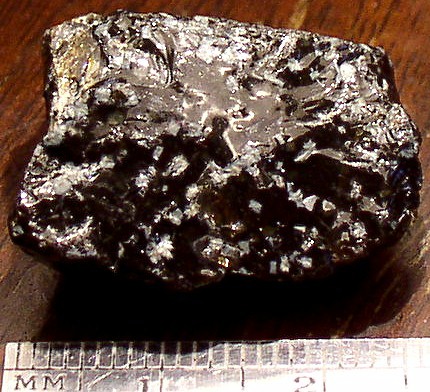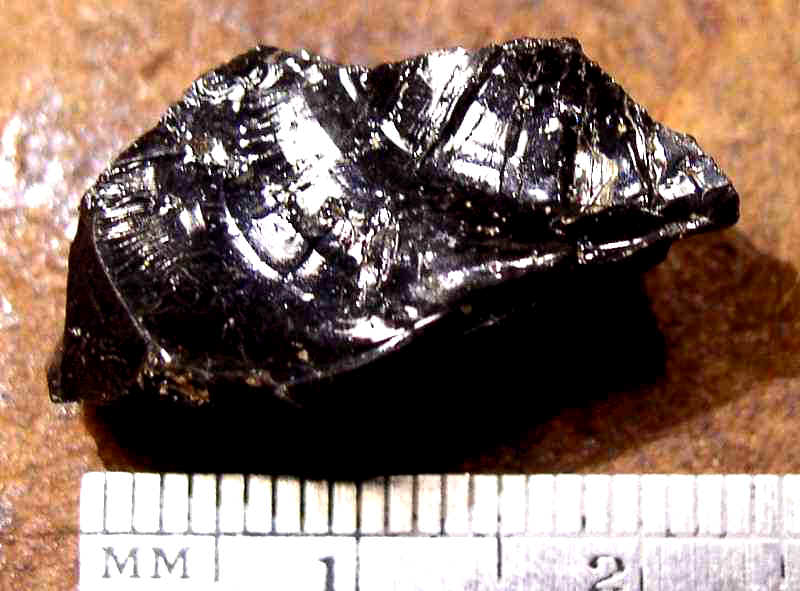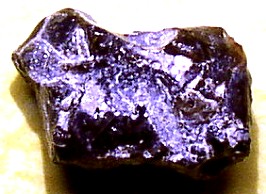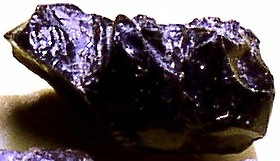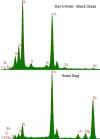|
Glass Artifacts - Day's Knob Site (Speculative - See Text Below)
These black glass objects at the Day's Knob site, often of a zoomorphic form character- istic of the lithic artifacts, were initially thought likely to be obsidian. However, an archaeologist in Ohio insisted from looking at photos that they must be road slag that somehow found its way into the woods. Although his earlier characterization (also from digital photos) of subsequently professionally identified non-local igneous and meta- morphic rocks as paving materials rendered his "slag" verdict more than a little suspect, it seemed prudent to more closely investigate the glass, since volcanic obsidian is not always easily visually distinguishable from byproducts of modern smelting. Several samples of the black glass were taken to the State University of New York in Buffalo for analysis by x-ray fluorescence spectroscopy, along with samples of locally used road slag. For comparison, the chart for one of these (essentially the same as for the others), and that for the slag, are shown below (click to enlarge): From its elemental composition it seems evident that the black glass is not road slag. However, to demonstrate that a glass is in fact obsidian, one must test for specific trace elements that characterize this. So, three samples were sent to the Northwest Research Obsidian Studies Laboratory in Corvallis, Oregon. Surprise - the material is not obsid- ian, but simply a black glass of unknown origin, somehow buried in various locations beneath the surface of the Day's Knob site. Click to enlarge the table below: The idea that glass making might have taken place in North America in prehistoric times is, of course, more than controversial, but the presence of material hinting at this possi- bility needs to be scientifically evaluated rather than summarily dismissed. After all, this technology is not terribly complex, and it is hardly inconceivable that ancient people on this continent experimenting with fire might have stumbled upon simple techniques for superheating materials. Glass was made in the "Old World" three thousand years ago, and metal was smelted there around five thousand years ago. At Day's Knob the material suggesting glass manufacture is mainly black, but glass of other colors has appeared in contexts in other Ohio locations that suggest considerable antiquity. Consider the flat-bottomed object below, which appeared about one meter (3.3') down in disturbed terrain in Guernsey County. This was kept only because it is strange and pretty (and very nearly discarded), but a few years ago it was noticed that this bears a face-like image much like many on lithic artifacts at Day's Knob. Speculative to be sure, but interesting.
After viewing this website, Dave Gillilan in Pickaway County, Ohio, reported to the author that while building a house he discovered at about 1.5 meters (5') down, in apparently undisturbed terrain, a cache of very nice flint and quartz points, blades and scrapers identified by experts as being likely Late Archaic to Early Woodland, i.e. roughly 2000 years BP. In this cache was the glass point shown below (cm scale): Many crude glass artifacts/byproducts appeared in immediate context, including the one shown below (janiform bird figure?). Strange and speculative, but the technology does now exist to objectively evaluate such finds. Engaging the interest of the archaeological "establishment" is, of course, another matter... David Stauffenberg has also found numerous glass artifacts of this type on the surface at a long inhabited site in North Carolina.
|
